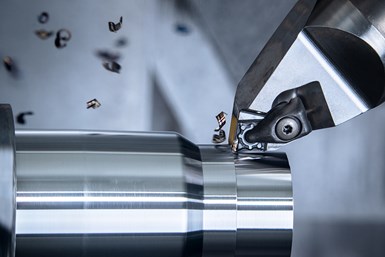Ceratizit Standard Insert Grades for Optimized Steel Turning
The inserts are engineered for increased productivity and feature advanced substrates, geometries and Ceratizit’s Dragonskin multilayer coating for lower heat and less tool wear.

The gold-colored TiN outer layer of the Dragonskin multilayer CVD Ti(C,N)/Al2O3/TiN coating acts as an indicator to help prevent insert waste and easily detect wear. Photo Credit: Ceratizit
Ceratizit has three new standard coated-carbide ISO-P steel insert grades for common steel turning operations which are said to provide up to 20% longer tool life when compared to previous generation grades. The inserts are highly engineered for increased productivity and feature advanced substrates, geometries and Ceratizit’s Dragonskin multilayer coating for lower heat and less tool wear, the company says.
To prevent insert waste and easily detect wear, the gold-colored TiN outer layer of the Dragonskin multilayer CVD titanium carbonitride (Ti(C,N))/aluminum oxide (Al2O3)/Titanium Nitride (TiN) coating acts as an indicator. It not only enables users to clearly identify insert wear and index before a breakage but also prevents sharp cutting edges from going unused and the insert being inadvertently discarded.
In addition, a mechanical postcoating treatment is said to produce beneficial residual stress in the coating which results in increased process security. Extra security can be especially important in large-volume production situations typically associated with turning ISO-P steels.
Each of the three grades are engineered for optimizing specific production scenarios. The CTCP115-P (ISO P15) grade has enhanced resistance to high temperatures and is well suited for use at higher cutting speeds in smooth, continuous cuts in stable cutting conditions. The CTCP125-P (ISO P25) universal steel-cutting grade is said to balance toughness and wear resistance to provide consistent reliability in turning operations ranging from finishing to rough machining. The CTC135-P (ISO P35) is a tough carbide grade for lower cutting speeds, interrupted cuts and unstable machining conditions.
Related Content
-
New Cutting Tool Technology Discovered at Paul Horn Open House
During a tour of the company’s campus in Tubingen, Germany, I and more than 3,000+ others were introduced to a number of new advances the company has made in cutting tool technology particularly as it relates to the medical industry.
-
Repeatability and Rigidity Are Key for Quick-Change Swiss Tooling
A rotary wedge clamping system is said to enable this two-piece, modular tooling system for Swiss-types to offer the performance of a solid tool.
-
Micromachining Fundamentals
A number of elements must come together to establish an effective process for machining at a micro level. Here we consider four.
.png;maxWidth=970;quality=90)












